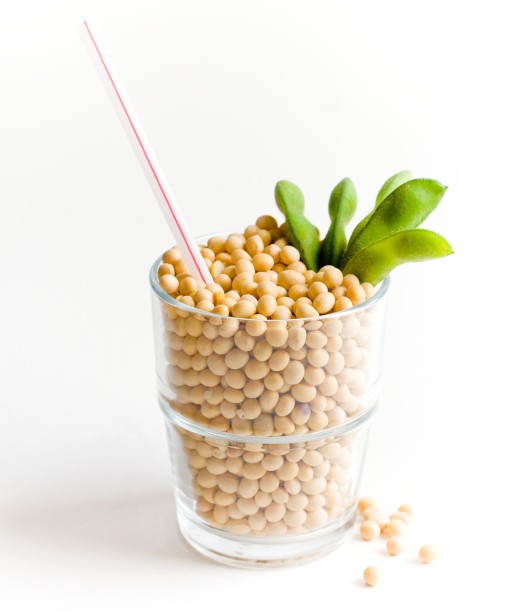In Checkout Line, Lou Bendrick cooks up answers to reader questions about how to green their food choices and other diet-related quandaries. Lettuce know what food worries keep you up at night.
Dear Lou,
I went to pick up some milk at our local mom-and-pop shop and noticed they had soy milk. Since it seems a lot of our friends have switched to soy milk, I thought I would try some. Oh, the choices! Not only were there three different organic soy milks, there were three rice milks and two hemp milks! Totally confused, I stuck with the organic milk from cows that I usually drink.
But this led me to wonder: what are the differences, nutritionally and sustainability-wise, in case I want to try a plant-based milk?
Thanks,
Lactose Intrigued…
Dear Lactose Intrigued … Happy, happy, soy, soy?Photo: diane555Not only are the choices intriguing, but how about the marketing nomenclature that brings to mind vegetables with mammaries?
Happy, happy, soy, soy?Photo: diane555Not only are the choices intriguing, but how about the marketing nomenclature that brings to mind vegetables with mammaries?
Am I alone in this? (Don’t answer.)
I empathize with you about the dizzying choices. I can’t believe it has come to this, but I am going to give you a few tips about navigating the alternative milk shelf. (Note to self: It may be time to buy a place in the country where I can live a simpler life. So long as I don’t have to buy milk there.)
Here are the tips:
• Get a reliable guidebook. (Gotcha! Just testing to see if you were truly awake after that tall soy chai tea latté.)
• OK (make serious face, clear throat): Although I can’t talk at length about the nutritional differences in plant milks (because that’s not my gig), I will say this: If you have health considerations, consult your doctor. Plant milks may be lactose-free, but each has its nutritional ups and downs and some perils lurk: rice milk is high in carbs, almond milk won’t work for those with nut allergies and the pros and cons of soy are controversial and mixed, to say the least. Also, read the labels carefully, bearing in mind that plants milks are processed foods. Keep an eye on sweeteners, additives, etc. On the upside, most of these milks are vitamin-enriched.
• Bear in mind taste (see below), because, let’s face it—if you think it’s yucky, the fact that it’s good for you or the planet is not going to matter. On that note, don’t expect milk. It’s sort of a shame that these juices are called milks because beyond their opaque color, they’re more juice-like than milk-like, and that can be a shock to the taste buds for a PMV (“plant milk virgin” — just remember, you heard that phrase here first).
• Milk alternatives can be pricey, and they come with difficult (or impossible)-to-recycle packaging and a carbon footprint produced by all that processing and long-haul travel. So if you like the stuff, consider making your own if you have the time. Surf the net for recipes for recipes such as this one.
Now let’s take a look at the alternatives you mentioned. I enlisted the help of my captive friends expert panel to do a little taste test. Although all of these milks come in sweetened, flavored forms (chocolate, vanilla, etc.), I stuck to unsweetened, unflavored versions so that we might experience the terroir of plant milks (that place in the country is looking better and better).
Soy milk
Environmental considerations: Not only is soy a high-spray, intensively-farmed crop, but most of the US crop is also genetically modified. Soy is so popular world-wide (it’s used as food for humans and livestock, and for making biofuels) that vast chunks of the Amazon rainforest are being cut down to grow soy, thus wrecking habitats and indigenous people’s lives and so forth.
Taste & appearance: Beige color; decent texture. In general the taste is sour. “Pure nastiness,” was the response from one tester, who, ironically does not consume any dairy. Another tested said, “spoiled.” Confession: I adore Silk chocolate soymilk, which is not surprising considering that I will adore pretty much any product that lists its second ingredient as “evaporated cane juice” and cocoa as its third.
Tip: Buy American-grown, identity-preserved USDA organic soymilk. If you want to find the organic American behind your soymilk, check out Find your Farmer function on the Organic Valley site. If you’re going to buy products using imported soybeans and you’re concerned about, oh, say, the fact that the Amazon rainforest produces about 20 percent of the earth’s oxygen, consider doing a little homework (grab those reading glasses). Lorenda Raiol, The Nature Conservancy’s Amazon resource information officer, says that you should find out where your soy comes from because in 2006 the Brazilian Association of Vegetable Oil Industries (ABIOVE) and the National Association of Cereal Exporters (ANEC) signed a “Soy Moratorium,” in which they committed to not buy soy from areas that were deforested in the Amazon biome after that date. “So, find out what companies are part of ABIOVE and ANEC, and reading the small letters on the labels is way to good start.” My two cents: Call companies or go to their websites for more information.
Rice milk
Environmental considerations: Rice, one of the most widely planted cereal crops worldwide, is intensively farmed, and it goes without saying that rice needs lots of water because it is grown in flooded paddies, which are sometimes contaminated with arsenic. The good news: New varieties of rice may make rice farming less intensive. The bad news: Some of these varieties are genetically modified (GM) and many countries around the world believe that GM foods are unsafe. A few years ago, the US provoked international ire by allowing some of our GMO rice to escape our borders.
Taste & appearance: Naturally sweet; watery texture. “Not bad,” said one taster. Another said, “Works with cereal.” I reach for it when I’m out of milk but I’d rather pound nails with my forehead than put it into my coffee.
Tip: Buy USDA organic. My husband and kids put organic Rice Dream on their cereal (read the label: not all Rice Dream is organic).
Hemp milk
Environmental considerations: According to Anndrea Hermann, an agronomist and board member of the Canadian Hemp Trade Alliance, hemp is a hardy, fast-growing crop that naturally suppresses weeds (because of its tall “canopy”) that resists many diseases and does not need lots of watering (big taproot). In other words, it doesn’t require intensive farming. Note: Organic hemp milk is available, but if the product isn’t organic bear in mind that the hemp in foods currently on American shelves comes from Canada, where it’s illegal to spray hemp crops that are used for food (conventional fertilizers may still be used). Go here to watch adorable Canadian farmers talk about hemp crops. Oh, Canada!
Taste & appearance: Putty colored and ever so slightly grainy. One taster described it as “chalky” and “not right at all.” I found it to be vegetal and slightly sour, but less so than soymilk. I like the taste of hemp seeds a lot more than the taste of hemp milk.
Tip: It will not cause you to giggle endlessly, inhale cold pizza, or fail a drug test. While it’s true that hemp foods come from the same plant that produces pot, hemp food plants are bred and processed in a way that renders their THC content negligible. The public misperception that hemp foods will get you high is rapidly fading, Hermann told me. “It would be like people worrying about their poppy seed muffins.”
Now, dear reader, I need to break it to you gently that the next time you venture beyond your mom-and-pop grocery store (if you must), you are likely to encounter an array of vegetable excretions that includes not only the above milks, but oat milk, almond and other nut milks, and coconut milk, which has been given a glamorous makeover from its old pina colada days.
According to Perry Abbenante, global grocery coordinator for Whole Foods Markets, coconut milk is turning up in non-dairy yogurt-style products, frozen non-dairy desserts, and non-dairy beverages. “It’s still in its infancy, but is definitely catching on.”
Are you perhaps wondering if coconut cultivation is ruining the planet like its evil cousin oil palm? Let’s save that for another column.
In the meantime, if you choose to stick with cow’s milk, keep buying organic. But if you ever get the chance, get milk that’s both organic and local. That’s a decision you don’t need a tasting panel to help with.
Your friend in food matters,
Lou



